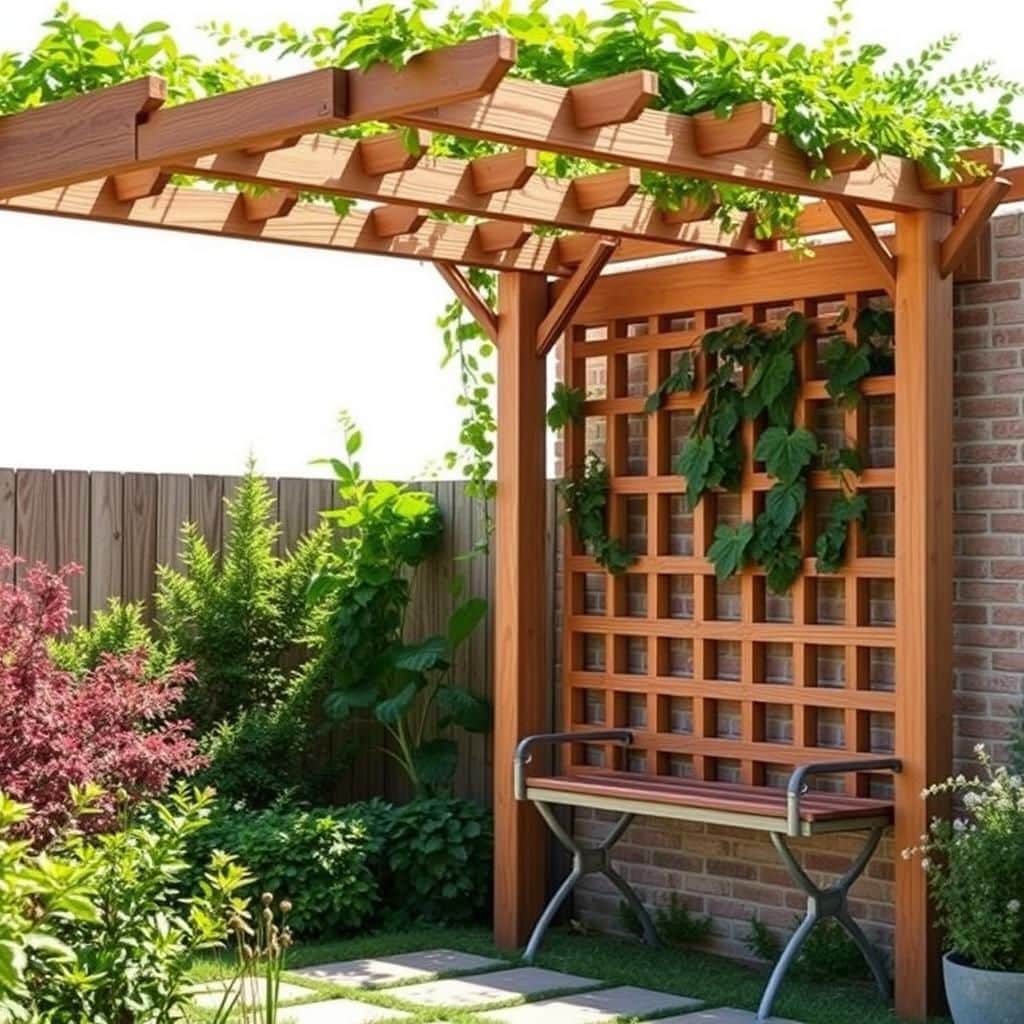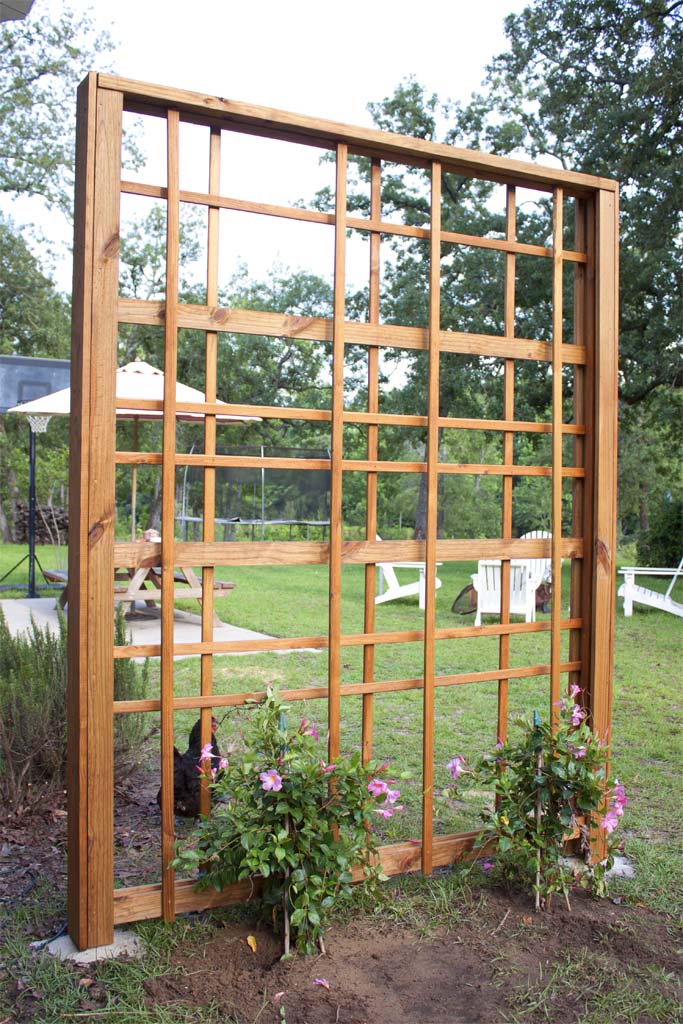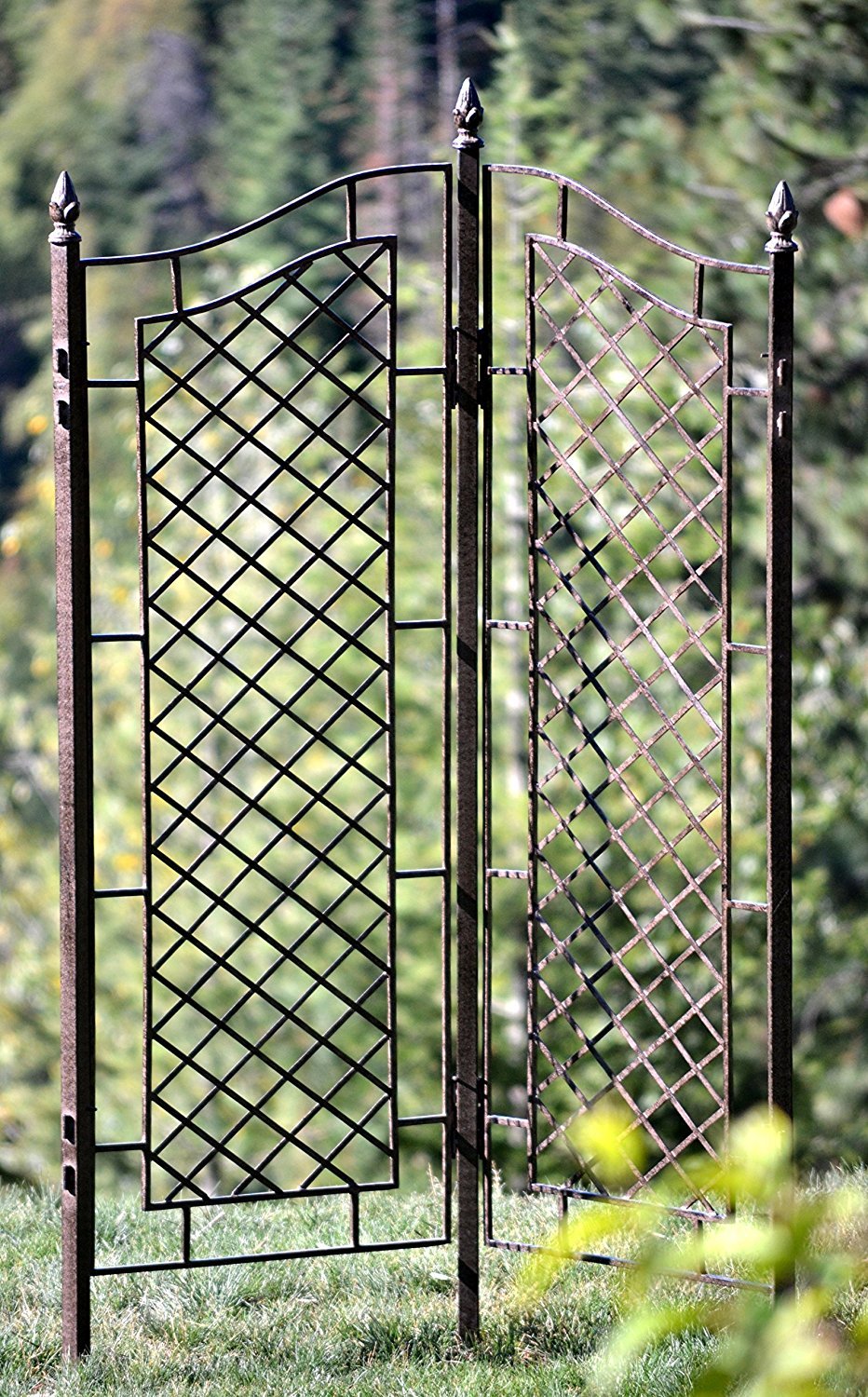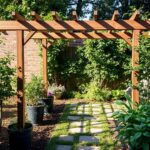What is a Freestanding Trellis? A Complete Guide to Understanding Its Uses and Benefits

A freestanding trellis is a versatile garden structure that provides essential support for climbing plants, while also serving as an aesthetic focal point in outdoor spaces. Unlike traditional wall-mounted trellises, freestanding versions can be placed anywhere in the garden, allowing for greater flexibility in design and plant placement. This complete guide will explore the various uses and benefits of freestanding trellises, including enhancing garden aesthetics, improving plant health, and optimizing space in small gardens. Whether you’re a seasoned gardener or a beginner, understanding the advantages of a freestanding trellis can elevate your gardening experience and transform your outdoor environment.
What is a Freestanding Trellis?
A freestanding trellis is a versatile gardening structure that supports climbing plants and vines independently, without being attached to a wall or another surface. Typically constructed from materials like wood, metal, or plastic, these trellises serve to enhance vertical gardening while providing adequate support for plant growth. They can be placed anywhere in a garden or yard, making them an ideal solution for small spaces where horizontal planting is limited. Freestanding trellises also contribute to garden aesthetics, creating an eye-catching focal point filled with lush greenery and vibrant flowers.
Types of Freestanding Trellises
There are several types of freestanding trellises available, each designed to accommodate different types of plants and aesthetic preferences. Traditional wooden trellises may feature a simple lattice design, perfect for climbing roses or ivy. Metal trellises, on the other hand, often offer a modern look with intricate designs, suitable for a contemporary garden style. Additionally, portable trellises allow for flexibility in positioning and can be moved as plant needs change. Ultimately, the choice of trellis depends on both the functional requirements of the plants and the visual appeal desired in the garden.
Benefits of Using a Freestanding Trellis
The use of a freestanding trellis provides numerous benefits for gardeners. Firstly, these structures allow for efficient space utilization by encouraging vertical growth, which is especially valuable in smaller gardens. Secondly, they improve air circulation around the plants, reducing the risk of fungal diseases. Thirdly, a freestanding trellis adds vertical interest to the landscape, creating a visual impact that enhances the overall garden design. Moreover, this type of trellis is easy to install and typically requires minimal maintenance, making it a practical choice for both novice and experienced gardeners.
Materials Used in Freestanding Trellises
Freestanding trellises can be made from a variety of materials, each with its own advantages and disadvantages. Wood is a popular choice due to its natural appearance and ability to blend seamlessly with garden surroundings; however, it may require treatments to prevent rot. Metal trellises, often made from wrought iron or aluminum, are durable and can withstand harsh weather conditions, but they might become too hot for certain plants. PVC and plastic trellises offer lightweight options that don't rust or rot, though they may not have the same aesthetic appeal as their natural counterparts. Choosing the right material depends on factors such as climate, plant types, and personal preference.
Installation Tips for Freestanding Trellises
Installing a freestanding trellis involves a few key steps to ensure stability and effectiveness. First, it is crucial to select an appropriate location that receives adequate sunlight for the climbing plants. The trellis should be securely anchored into the ground, often by burying a portion of the legs to prevent tipping over in strong winds. It is also important to space the trellis adequately from surrounding plants to allow for unrestricted growth. Finally, utilizing ties or clips to gently attach the plants to the trellis can promote upward growth and help the vines adhere properly.
Popular Plants for Freestanding Trellises
Certain plants are particularly well-suited for growth on freestanding trellises, making the selection of climbing species an important consideration. Vines like sweet peas, clematis, and morning glories thrive when provided with vertical support. Fruiting plants such as cucumbers and climbing beans also benefit from trellis systems, as they can be trained to grow upwards while remaining within easy reach for harvesting. Additionally, flowering plants like pigeon peas and jasmine enhance the beauty of the trellis while offering fragrance and visual appeal. The ideal plant selection will depend on regional climate and individual garden preferences.
| Type | Material | Benefits |
|---|---|---|
| Wooden Trellis | Wood | Natural appearance and supports diverse plants. |
| Metal Trellis | Iron/Aluminum | Durable and withstands harsh weather. |
| Plastic Trellis | PVC/Plastic | Lightweight and resistant to rust. |
How do you support a freestanding trellis?

To support a freestanding trellis, it is essential to ensure stability and durability for climbing plants to thrive. Here are several effective methods to achieve this support:
1. Select the Right Location: Choose a spot that provides adequate sunlight and space for plants to grow.
2. Foundation: Set the trellis within a solid base. You can create a concrete or gravel foundation to prevent any wobbling.
3. Anchoring: Use stakes or concrete anchors to secure the base of the trellis. This will prevent it from falling over in high winds or during the weight of the plants.
4. Materials: Choose sturdy materials for your trellis, like treated wood, metal, or reinforced plastic that can withstand weather conditions.
5. Cross Bracing: Incorporate cross bracing at the back of the trellis. This method adds tension to the structure and keeps it upright.
Importance of Proper Materials
Using the right materials for your trellis impacts its durability and ability to support plants. The most common materials include:
- Wood: Treated lumber is commonly used for its aesthetic appeal and strength.
- Metal: Options like steel or aluminum provide additional durability and are resistant to rot.
- Plastic: Lightweight and resistant to weather, making installation easier, though less robust.
Design Considerations
The design of your trellis is crucial for proper support and functionality. Factors to consider include:
- Height: Ensure the trellis is tall enough to accommodate the growth of climbing plants.
- Width: A wider base provides stability and allows more plants to be trained on the structure.
- Shape: Designs vary from flat panels to arches; choose based on aesthetic preference and plant type.
Soil Preparation
Proper soil preparation is essential for the stability of the trellis. Consider the following steps:
- Digging: A deep hole or trench can help secure the base, especially if using vertical supports.
- Amendments: Enhancing soil quality will promote root system growth for both the plants and the trellis supports.
- Drainage: Ensure that the area allows for water drainage to prevent erosion around the trellis base.
Regular Maintenance
Ongoing care is vital for the longevity of the trellis. Regular maintenance considerations include:
See also:
- Inspection: Check for any signs of damage or looseness at the base of the trellis.
- Cleaning: Remove debris and foliage that may interfere with the trellis structure.
- Reinforcement: Add additional support or replacement parts as needed to maintain stability.
Plant Selection and Training
Choosing the right plants and training them properly can significantly impact the effectiveness of the trellis support. Key considerations are:
- Climbing Species: Select plants known for their climbing abilities, like beans or roses.
- Training Techniques: Use ties or clips to direct plants towards the trellis for optimal support.
- Weight Considerations: Be aware of the eventual weight of mature plants to ensure your trellis is adequately supported.
How to install a freestanding trellis?

To install a freestanding trellis, you'll need to follow several key steps to ensure stability and functionality. A freestanding trellis is versatile and can be used in various garden settings to support climbing plants and enhance your landscape's visual appeal. Here’s a detailed guide on how to install one properly.
Choosing the Right Location
Selecting the appropriate location for your freestanding trellis is crucial for its success and longevity. Look for an area that receives sufficient sunlight and is conveniently accessible for maintenance.
- Sunlight Exposure: Ensure the site has at least 6-8 hours of sunlight daily for optimal plant growth.
- Proximity to Plants: Choose a spot that is close to the plants you intend to support to make training them easier.
- Wind Protection: If possible, place the trellis in a sheltered spot to protect it from strong winds that could topple it.
Gathering Materials and Tools
Before beginning your installation, gather all necessary materials and tools. Having everything ready will streamline the process and prevent interruptions.
- Trellis Material: Choose from wood, metal, or plastic depending on your aesthetic preference and durability needs.
- Fasteners: Obtain screws, nails, or brackets for securing the trellis in place.
- Tools: Prepare essential tools such as a drill, level, tape measure, and a saw if adjustments are needed.
Preparing the Ground
Proper ground preparation is essential for a secure and stable installation. The ground must be level and appropriately packed for the trellis to stand firmly.
- Clearing the Area: Remove any grass, weeds, or debris from the spot where you’ll be placing the trellis.
- Leveling the Ground: Use a rake to ensure the ground is even, which helps prevent structural issues later.
- Packing the Soil: Firmly pack the soil where the trellis will stand to provide a solid foundation.
Installing the Base
The base is critical for the stability of a freestanding trellis. Proper installation of the base will support the weight of climbing plants over time.
- Digging Holes: If your trellis has posts, dig holes that are deep enough (about 1/3 the post length) to anchor them securely.
- Setting the Posts: Place the posts in the holes, ensuring they are vertical using a level, and fill the surrounding space with soil.
- Securing the Base: Add concrete mix to the holes to ensure extra stability if necessary, particularly for taller trellises.
Attaching the Trellis Panel
Once the base is in place, you can attach the trellis panel. This step is essential as it brings together the entire structure.
- Aligning the Panel: Hold the trellis panel against the post, making sure it remains straight and level.
- Fastening the Panel: Use screws or brackets to securely attach the panel to the posts, ensuring it’s firmly anchored.
- Final Adjustments: Check the vertical alignment once more and make any necessary adjustments before fully securing.
How to make a free standing trellis?

To create a free-standing trellis, you will need to follow several steps and gather the appropriate materials. A free-standing trellis can serve as a decorative feature in your garden or provide support for climbing plants such as vines, roses, or cucumbers. Here’s how you can make your own:
Materials Needed
1. Wooden posts (typically 2x4 or 4x4)
2. Trellis panels or lattice
3. Wood screws or nails
4. Hinges (optional, if making a movable trellis)
5. Wood finish or stain (optional for weather resistance)
Instructions
1. Design Your Trellis: Decide on the size and style of your trellis. Sketch your design, including dimensions, to ensure you have an idea of how it will look and how to construct it.
2. Cut Posts and Panels: Measure and cut your wooden posts and trellis panels according to your design. Common trellis height is between 6 to 8 feet.
3. Assemble the Frame: Start by attaching the trellis panels to the wooden posts using screws or nails. Ensure that the panels are secure and evenly spaced. Use a level to check that everything is straight.
4. Create Stability: To ensure that your free-standing trellis does not tip over, consider adding a wider base or anchor the trellis with additional wooden beams diagonally to the back posts.
5. Finishing Touches: If desired, apply a wood finish or stain to protect your trellis from weathering. Let it dry completely before placing it outside.
See also:
Choosing the Right Location
Selecting the appropriate location for your trellis is crucial for both aesthetic and practical reasons. Here are some considerations:
- Sunlight: Ensure the area receives enough sunlight for the plants you intend to grow.
- Visibility: Place your trellis where it can be admired or seen from your home or main pathways.
- Soil Condition: Check the soil quality, ensuring it is suitable for the climbing plants you will use.
Types of Plants for Your Trellis
When choosing plants for your trellis, consider varieties that thrive in your particular climate. Common options include:
- Climbing Roses: Beautiful and fragrant, perfect for adding elegance.
- Vining Vegetables: Such as beans and cucumbers, which can also help utilize vertical space.
- Flowering Vines: Like morning glories or clematis, which can add vibrant colors to your garden.
Maintenance Tips
To ensure that your trellis and the plants it supports thrive, regular maintenance is necessary. Consider these tips:
- Pruning: Regularly prune your climbing plants to encourage healthy growth and remove any dead branches.
- Watering: Ensure plants are adequately watered, especially in dry spells, but avoid overwatering.
- Check Stability: Periodically inspect the trellis structure for stability and make any necessary repairs.
Decorative Ideas for Your Trellis
A trellis can offer more than just plant support; it can also serve as a decorative element in your garden. Here are some ideas:
- Lighting: Incorporate string lights or lanterns for an enchanting evening atmosphere.
- Hanging Decorations: Consider adding hanging plants or decorative items to showcase your style.
- Paint or Stain: Use different colors or finishes on your trellis to match the overall theme of your garden or outdoor space.
Building Considerations
Before starting your project, there are some important construction considerations:
- Tools: Ensure you have all necessary tools, including a saw, drill, level, and measuring tape.
- Safety: Wear safety gear such as gloves and goggles to prevent injuries while constructing.
- Local Regulations: Check local regulations regarding garden structures to ensure compliance with any ordinances or restrictions.
What's the difference between a lattice and a trellis?

The terms lattice and trellis are often used interchangeably in gardening and landscaping contexts, but they refer to different structures with distinct purposes and designs.
A lattice is typically a framework made of crossed wood, plastic, or metal strips that form a grid-like pattern. It serves several functions, including providing a decorative backdrop, creating privacy, and supporting climbing plants. Lattice is commonly used in fences, garden screens, and structure aesthetics.
In contrast, a trellis is primarily a support structure for climbing plants, featuring an open framework that allows vines and flowers to grow upward. Trellises can be freestanding or attached to walls and are designed to guide plants in their growth direction, ensuring they receive adequate sunlight and air circulation.
Material Differences
Different materials are used for constructing lattices and trellises, which can affect their durability and aesthetic appeal.
- Lattice structures are often made from wood, vinyl, or metal, offering a range of decorative options.
- Trellises can be constructed from similar materials but are frequently made with lighter options like bamboo or thin wooden slats to support climbing plants.
- Some lattices are finished with paint or stain for aesthetic purposes, whereas trellises may be left natural to blend with garden foliage.
Design Purpose
The design intent behind lattices and trellises is notably different, impacting their use in landscaping.
- A lattice is designed to create a visually appealing backdrop or enclosure in gardens while providing privacy.
- A trellis serves specifically as a support mechanism for vines, flowers, and other climbing plants to grow vertically.
- While lattices can be decorative, trellises are functional, focusing on plant health and optimal growth conditions.
Installation and Maintenance
The process of installing and maintaining lattices and trellises can differ significantly based on their designs and functions.
- Installing a lattice often involves securing it to existing structures like fences or walls, which can be done using basic tools.
- In contrast, a trellis may require anchoring in the ground if freestanding, which may involve digging or staking.
- Maintenance for a lattice may involve periodic painting or staining to maintain aesthetics, whereas a trellis will need monitoring for plant growth and may require adjustments as plants mature.
Common Uses in Landscaping
The applications of lattices and trellises in garden design can differ based on what gardeners wish to achieve.
- In gardens, lattices are often used as privacy screens and decorative elements, enhancing aesthetic appeal.
- Trellises are more commonly utilized in vegetable or flower gardens, allowing plants like tomatoes or climbing roses to thrive vertically.
- Additionally, lattices may be employed in outdoor seating areas for added shade and privacy, while trellises are typically positioned where plants can easily access sunlight.
Aesthetic Preferences
The visual impact of lattices and trellises can vary widely, influencing their selection in garden design.
- A lattice can add intricate beauty to a space with its crisscross patterns, often serving as a focal point.
- Trellises, while functional, may not always provide the same level of ornamental appeal unless adorned with climbing plants.
- Gardeners might choose a lattice for a more structured design or a trellis for a softer, organic look achieved through plant growth.
Questions from Our Readers
What is a freestanding trellis?
A freestanding trellis is a structure designed to support climbing plants, typically made from materials like wood, metal, or vinyl. Unlike wall-mounted trellises, a freestanding trellis can be placed anywhere in the garden, providing flexibility in plant arrangement and design.
How does a freestanding trellis benefit plants?
A freestanding trellis enhances plant growth by providing vertical space for climbing plants, which in turn allows for better air circulation, sunlight exposure, and easier access for maintenance. This structure also helps to keep fruits and flowers off the ground, reducing the risk of rot and pests.
Can a freestanding trellis be used for any type of plant?
Yes, a freestanding trellis can be utilized for various climbing plants, including vines, roses, and certain vegetables. It is essential to select a trellis that can adequately support the weight and growth habits of the specific plant species you intend to grow.
What materials are commonly used to make a freestanding trellis?
Freestanding trellises are commonly crafted from durable materials such as wood, metal, or synthetic materials. Each material has its advantages, with wood providing a natural look, metal offering strength and longevity, and synthetic options being low-maintenance and weather-resistant.
See also: Can a Trellis Be Free Standing? Exploring the Benefits and Design Ideas
Can a Trellis Be Free Standing? Exploring the Benefits and Design Ideas
If you want to read more articles like What is a Freestanding Trellis? A Complete Guide to Understanding Its Uses and Benefits, we recommend you check out our Trellis category.
Leave a Reply
Related Articles